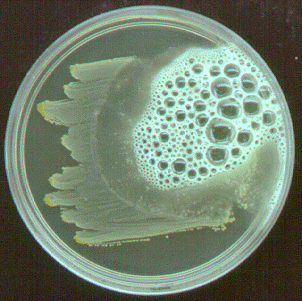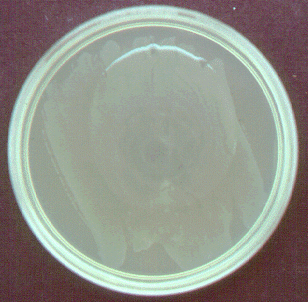8.6: Catalase Activity (Demonstration)
- Page ID
- 123382
Catalase is the name of an enzyme found in most bacteria which initiates the breakdown of hydrogen peroxide (H2O2) into water (H2O) and free oxygen (O2).
During the normal process of aerobic respiration, hydrogen ions (H+)are given off and must be removed by the cell. The electron transport chain takes these hydrogen ions and combines them with half a molecule of oxygen (an oxygen atom) to form water (H2O). During the process, energy is given off and is trapped and stored in ATP. Water is then a harmless end product. Some cytochromes in the electron transport system, however, form toxic hydrogen peroxide (H2O2) instead of water and this must be removed. This is done by the enzyme catalase breaking the hydrogen peroxide into water and oxygen as shown above. Most bacteria are catalase-positive; however, certain genera that don't carry out aerobic respiration, such as the genera Streptococcus, Enterococcus, Lactobacillus, and Clostridium, are catalase-negative.
Trypticase Soy agar cultures of Staphylococcus aureus and Streptococcus lactis, 3% hydrogen peroxide.
PROCEDURE (demonstration)
Add a few drops of 3% hydrogen peroxide to each culture and look for the release of oxygen as a result of hydrogen peroxide breakdown. This appears as foaming and indicates the organism is catalase-positive. See Fig. . If the organism does not have the enzyme catalase, then the hydrogen peroxide will not be broken down into water and oxygen and no foaming will be seen. See Fig. .
|
Fig. : A positive Catalase Test. |
Fig. : A Negative Catalase Test. |
|---|---|
 |
 |
| A Catalase Test on Staphylococcus aureus, a catalase-positive bacterium | A Catalase Test on Streptococcus lactis. The genus Streptococcus and the genus Enterococcus are catalase-negative. |
| (Copyright; Gary E. Kaiser, Ph.D. The Community College of Baltimore County, Catonsville Campus CC-BY-3.0) | |
RESULTS
Catalase is the name of an enzyme found in most bacteria which initiates the breakdown of hydrogen peroxide (H2O2) into water and free oxygen.
- If the bacterium produces the enzyme catalase, then the hydrogen peroxide added to the culture will be broken down into water and free oxygen. The oxygen will bubble through the water causing a surface froth to form. This is a catalase-positive bacterium (see fig. ).
- A catalase-negative bacterium will not produce catalase to break down the hydrogen peroxide, and no frothing will occur (see Fig. ).
Catalase Test
Record your results below (foaming = positive; no foaming = negative).
| Organism | Catalase Reaction |
|---|---|
| Staphylococcus aureus | |
| Streptococcus lactis |
Contributors and Attributions
Dr. Gary Kaiser (COMMUNITY COLLEGE OF BALTIMORE COUNTY, CATONSVILLE CAMPUS)

